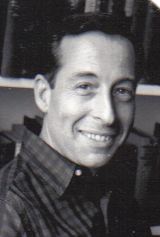 |
Sheldon Kranz Aesthetic Realism Consultant, Writer, Poet (1919-1980) |
Last
week, Mr. Siegel discussed play,
and showed how it is related to
work.
He showed how Aesthetic Realism
sees play as not opposed to work, and how both must be seen fully and
accurately for a person to feel good. “Play”
Has a Purpose "The
purpose of play," said Mr. Siegel, "is to find an absence of
seriousness in the world, and yet find the world worthy of respect." We can see this clearly in a child playing. He is having fun, but he is also serious
about his game. We can see it in a
kitten playing with a piece of twine. Too
often, Mr. Siegel said, "people have felt that play is
superfluous, superficial. They have not
seen it having the same purpose as work. Aesthetic Realism says that
gaiety is
part of reality. If a person doesn't
see the world gaily he doesn't see it sincerely. Gaiety is also after
truth. Where it isn't, it is false and
bad. Gaiety, as part of the world must be honored.
But people use it not to respond wholly or truly to things. They use it as an evasion, as a way of
getting away from accuracy and feeling. Seeing the light or ridiculous,
said
Mr. Siegel, does not mean we are not seeing the truth.
Where we see gaiety, we are seeing the world
not as an obstruction or an obstacle. People
do not use either seriousness or gaiety as a way of
knowing the
world better, but simply for their own convenience. Play and Art Opposites
in Play If we
look at play, as at a painting, we will see that opposites are put
together.
Mothers should understand the seriousness of a child's playing. There
is
seriousness and non-seriousness. There
is heaviness and lightness. In
painting, a person can feel very intense, and yet be enjoying himself
immensely. Wherever there is activity
or motion, there is play, but it can have strictness, too, as in chess.
There
is freedom, but there is also accuracy. A
Scene
from Dickens' Pickwick
Papers To show
how play can be furious and mirthful, and yet serious and concentrated,
Mr.
Siegel read the ice-sliding sequence from Dickens' Pickwick Papers.
In this scene, Mr. Pickwick, Sam Weller and
others slide along the ice again and again, having a fine time while
others are
ice skating. The sliding is gay and smooth, but Sam Weller’s special
game
called "knocking on the cobbler's door" shows defiance.
The ice skating seems to be the most
important thing in the world at that moment. There
is seriousness in the play. "The whole
book makes mirth deep as it should be," said
Mr.
Siegel. "Children know this." Depth in Children’s Games There
is a deep desire for the world to make sense to us, to see it as
orderly. This can be seen in the games
children
play. Mr. Siegel read several games and
songs children play, showing how they are deep, as children are, and
are about
the most important things a person can deal with: the relation of
himself or
herself as one to the world seen as many. In
"Green Gravel," the individual and collective are
seen. Green gravel itself, is putting
together smoothness and roughness. "The
Mulberry Bush" is gay, but it is all about work. The
two have been put together
gracefully. "The Farmer in the
Dell," shows the same thing. A
hard working farmer is placed in a romantic place--a dell. A
Critical
Poem Mr.
Siegel then read a poem of Sarah Cleghorn, "The Golf Links," which
involves work and play. In this poem,
children working hard at the mill can see the adults playing on the
golflinks: The
golf links lie so near the mill,
That almost every day, The labouring children can look out, And see the men at play. The
other is something in all people who don't want to see play deeply. They are the people who stop others from
playing, because they do not understand it. “Reality,"
Mr. Siegel said, "did not make the frisking
lamb
for nothing. There is the solid oak and
the swaying grass. Both should be seen as real." Opposition and Release The
self wants opposition and release, heaviness and lightness. Where opposition is preponderant, it seems
to be work; where release is preponderant, it is play.
Whatever the world does, though, we must see
it as for us. We can then have a deep
sense of play. The greatest humor is
the most serious humor. “Casey at the Bat” |
|
Copyright: Sheldon Kranz, Aesthetic Realism Consultant (1919-1980)